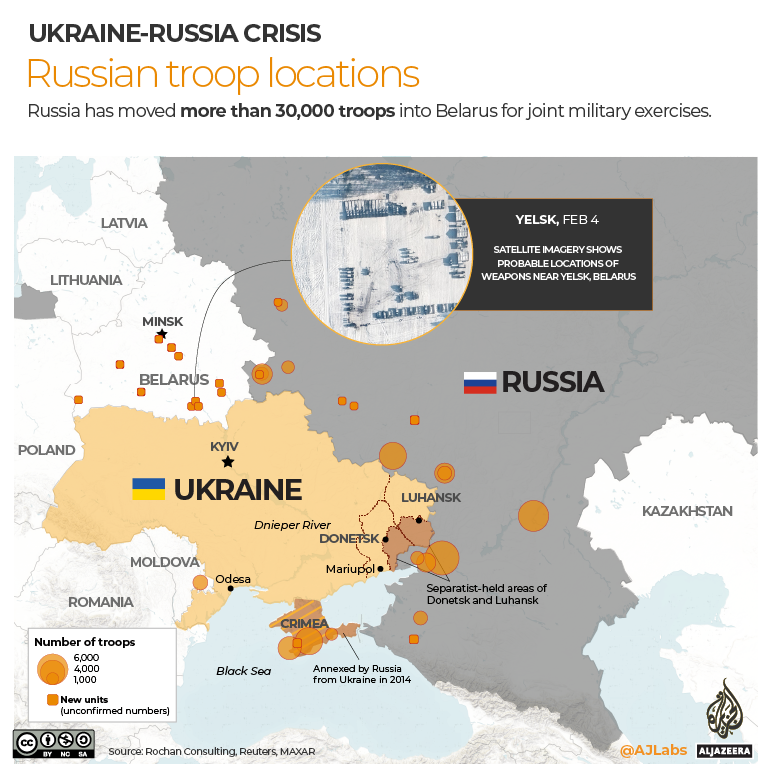NATO and the Ukraine-Russia crisis: Five key things to know
Moscow has the future of the US-led transatlantic military alliance in its sights as Kyiv eyes membership.

The future of NATO, the transatlantic security alliance, is at the centre of the standoff between Russia and the West over Ukraine.
Moscow wants guarantees that its neighbour, a former Soviet state, will be permanently barred from joining the United States-led alliance. It has also called for NATO to cease all military activity in Eastern Europe, blaming it for undermining security in the region.
Keep reading
list of 4 items‘Babushka battalion’ ready to protect Ukraine from Russia
Russia says ready to continue diplomacy amid Ukraine crisis
Eastern Europe braces for refugees as Ukraine tensions simmer
But Western leaders have rejected those demands. They have argued the Kremlin cannot be allowed an effective veto on Kyiv’s foreign policy decisions and defended NATO’s “open door policy”, which grants any European nation the right to ask to join.
Amid the deadlock, here are five things you need to know about NATO:
1. What is NATO and why was it formed?
The North Atlantic Treaty Organization was founded in 1949, in the aftermath of World War II.
The alliance was initially part of an effort by the US and its European allies to deter any expansion of the then-Soviet Union (USSR) and reduce the possibility of conflict on the continent by encouraging greater political integration between its powers.
In the decades since, it has steadily expanded its orbit, bringing a swathe of central and eastern European states into its ranks after the USSR collapsed.
This enlargement has troubled Moscow, which is wary of the Brussels-headquartered alliance edging ever closer to its borders and hemming it in from the West.
2. Which countries are member states?
NATO is comprised of 30 member states.
Belgium, Canada, Denmark, France, Iceland, Italy, Luxembourg, the Netherlands, Norway, Portugal, the United Kingdom and the US were its founding members.
The newest member state is North Macedonia, which joined in 2020.
Three so-called partner countries – Ukraine, Bosnia and Herzegovina and Georgia – have declared their aspirations to become part of the alliance, which says its purpose is “to guarantee the freedom and security of its members through political and military means”.

3. Why does Ukraine want to join NATO?
Ukraine has repeatedly stated its intention to become a NATO member state – an objective that is written into the country’s constitution.
Joining the alliance would boost Ukraine’s defensive strength, because of NATO’s principle of collective defence. That principle – set out by Article 5 in NATO’s founding treaty – means an attack against one ally is considered as an attack against all allies, committing them to protect one another.
4. Does NATO support Ukraine?
In 2008, NATO leaders promised Ukraine it would one day be given the opportunity to join the alliance. But despite deepening cooperation in the years since, there is thought to be little chance of that happening any time soon.
Western powers are yet to be convinced Kyiv has done enough work to eradicate corruption and meet the other political, economic and military criteria required to enter the alliance, as set out in its 1995 Study on Enlargement.
NATO’s members may also be wary of Ukraine joining their ranks while tensions with Moscow remain high, as such a move could draw them into a direct conflict with Russia in the event it launches an attack, because of the collective defence principle.
On Monday, German Chancellor Olaf Scholz said the issue was “not on the agenda” following talks with Volodymyr Zelenskyy in Kyiv, despite Ukraine’s president restating his country’s membership ambition.
All 30 NATO allies must unanimously approve a new country becoming part of the alliance.
5. What is the problem between Russia and NATO?
Putin has said it is now time for NATO’s waves of expansion to be reversed and for the alliance to guarantee that Ukraine never be allowed to become a member.
He argues that the West has betrayed Moscow by breaking alleged verbal commitments made at the end of the Cold War that NATO would not expand eastwards. The alliance denies that any such promises were made.
In a show of force, Russia has massed more than 100,000 troops around Ukraine’s borders and sent sweeping security demands to Washington and NATO.
In response, the alliance, the US and its European allies have been scrambling to negotiate with Moscow and de-escalate the situation.
But the high-stakes diplomatic efforts have borne little success. Washington and NATO have rejected the Kremlin’s central demands – that the alliance cease all military activity in Eastern Europe and Ukraine be barred from membership – while Russia has refused to budge on its requests.
As tensions continue to simmer, Western leaders, including US President Joe Biden, have made clear they will not send troops to defend Ukraine in the event of a Russian invasion.
But several of Kyiv’s allies in NATO, with the exception of Germany, have supplied Kyiv with weapons as it ramps up preparations to repel a potential incursion. Meanwhile, NATO has moved to reinforce its eastern flank with additional troops and military hardware.
